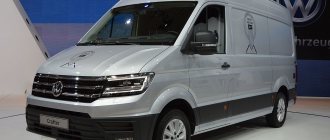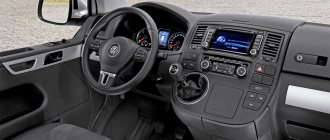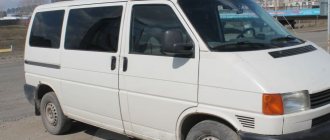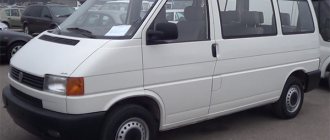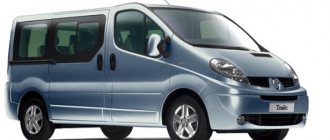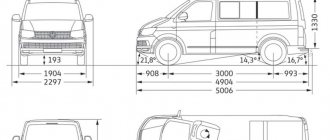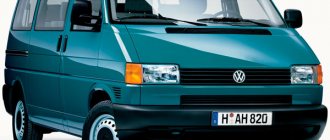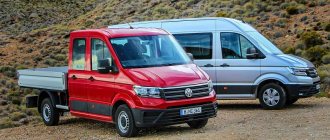The lineup
Volkswagen passenger minibuses: buy now, don’t delay the implementation of your plans
Caravelle Trendline
Comfortable minibus for passenger transportation. A wide selection of interior transformations and configurations is offered. A configuration of 5 to 9 seats is possible. Equipped with a diesel engine of 84.102 or 140 hp. A twin-turbocharged 180 hp engine is also offered. The range of petrol engines includes 150 and 204 hp engines. The gearbox is a 6-speed, but the 180 PS bi-turbodiesel engine is an option. and for the petrol 204 hp it is possible to equip it with a 7-speed dual-clutch DSG gearbox and a separate option for 4MOTION all-wheel drive is available. Engines comply with Euro 4.
Caravelle Trendline long wheelbase
In addition to all the advantages mentioned above, it gives an additional 400 mm of body length, increasing the capacity and comfort of passengers. The number of seats can be increased to 10.
Caravelle Comfortline with short and long wheelbase
These cars are characterized by increased comfort for the driver and passengers. In particular, there is central locking, electrically adjustable and heated exterior mirrors, semi-automatic air conditioning, durable carpet flooring, and ventilation deflectors and additional lighting are installed in the ceiling. The appearance of the car is also significantly improved.
Multivan Startline
A minibus with a spacious and comfortable interior. The base model includes an active safety complex “Adaptive ESP+” consisting of an electronic stability control system (ESP), emergency brake assist (EBA), hill start assist (HSA), anti-lock braking system (ABS), electronic differential lock system (EDS) as well as other design solutions to ensure the highest possible safety. Equipped with diesel engines 84, 102 and 140 hp. as well as petrol 116 (Otto) and 150 hp. with 5- and 6-speed gearboxes. Interior comfort has been improved compared to the Caravelle. The base includes a folding rear three-seater sofa, air conditioning, and a table.
Multivan Comfortline
This minibus has two additional seats with the possibility of transformation, an improved version of the table and ceiling panel. Generally characterized by increased comfort and improved appearance. They are equipped with an additional 180 hp diesel engine. and gasoline 204 hp.
Multivan Comfortline long
Thanks to the extended base, it can accommodate 8 seats. It is possible to transform the interior. Multivan Highline A car of increased comfort compared to previous ones. It is equipped, among other things, with three-zone Climatronic air conditioning, electric side doors with soft-closers, a rear door with soft-closers, fog lights, leather upholstery, and an anti-theft alarm with interior monitoring.
Multivan PanAmericana
In fact, this is already a powerful SUV, with 20 mm more ground clearance, 4Motion all-wheel drive and an additional mechanical locking of the rear axle differential. To increase cross-country ability, you can optionally add an extreme Offroad package that increases ground clearance by 30 mm, including durable metal crankcase protection and A/T tires of size 235/65 R17 Multivan Edition 25, Multivan Edition 25 Life Compared to previous models, they have higher comfort and beauty and elegant appearance. Equipped with 4Motion all-wheel drive.
Crafter
Based on the Crafter 35 and 50, with short and long wheelbases, standard high and extra-high roofs, Russian companies, together with Volkswagen, produce a wide range of intercity and city minibuses, small and tourist buses with a number of seats from 13 to 26 and a large number of interior configuration options. More about Crafter>>>
Minibus Volkswagen Multiven
Minibus Volkswagen Multiven
perfectly combines the roominess of a minivan and the comfort of a limousine with the practicality of a crossover. The solid appearance is successfully emphasized by new design details with small chrome inserts. It's safe to say that this minibus is for VIP passengers. The driver's seat is in no way inferior to large SUVs in terms of comfort and ergonomics. But the rich equipment and dimensions of the passenger compartment are at a higher level. And in terms of all kinds of transformations, the interior of the Volkswagen Multiven minibus can generally be called a model in its class.
Despite the rather modest external dimensions, quite comparable to E-class cars, the inside of the cabin seems much larger. Get into the cabin from the driver's seat or turn the individual seats of the passenger row to 180
degrees - no problem.
The central transforming table also arouses some interest. The side doors are equipped with electric drives, while the rear door does not have one, which is somewhat surprising. Some elements in the cabin can be easily moved in different directions, and, if necessary, quickly dismantled. In the roof and floor of the Volkswagen Multivan minibus there are special rigging loops for securing luggage. This minibus is equipped with a high-tech engine of the latest generation, the volume of which is only 2
liters.
But, despite the rather modest indicator, it gives 180
horsepower and develops a torque of
400 Nm
, which is available already at
1.5
thousand rpm. The Volkswagen Multiven minibus has electronically controlled all-wheel drive, combined with fairly sharp steering and the ESP electronic assistance system. Thanks to this, you can achieve not only excellent dynamics, but also complete control over this car. When the ESP system is turned off, the Volkswagen Multiven minibus effectively rows with all its wheels, and on slippery areas it can even be sent sliding sideways. At the same time, do not forget that a high body is less stable.
Despite the advanced all-wheel drive of the latest generation, the Volkswagen Multiven is not an SUV, but in terms of its functionality it is a true universal car. The Volkswagen Multiven minibus is equipped with heated front and rear windows, fog lights with cornering lights, a self-dimming interior rear-view mirror, electric front windows, 3-zone climate control, heated first-row seats, central locking, rain sensor, on-board computer, front airbags . Also, the Volkswagen minibus is equipped with electronic safety systems – ESP+, Read Assist, Side Assist and Park Pilot.
Price for minibus Volkswagen Multiven
starts at
$51 thousand.
Technical characteristics of the Volkswagen minibus:
* Car length – 4892 mm.
* Car width –
1904 mm.
* Vehicle height –
1970 mm.
* Ground clearance –
167 mm.
* Wheelbase –
3000 mm.
* Curb weight –
2181 kg.
*Trunk volume –
4300 liters.
* Engine capacity –
1968 cm/cc.
* Maximum power –
180 hp, at 4000 rpm.
* Torque –
400 Nm, at 1500 rpm.
* Maximum speed –
191 km/h.
* Transmission –
7-speed automatic.
* Average fuel consumption per
100 km is 8.1 liters.
Save and Share:
Volkswagen minibuses
More than fifty years ago, in the still young Federal Republic of Germany, a new car appeared, the Volkswagen Bulli (Bull), or T1, which would later bear the name Volkswagen Transporter. Simple, but with an uncontrollable desire to conquer the world...
(1950-1967) T1
Having established mass production of Beetle passenger cars, Volkswagen began developing a second “people's car”. And now the Typ2 universal-purpose truck rolled off the assembly line, inheriting the main design features of the legendary Beetle: an air-cooled engine located at the rear, a monocoque body and independent suspension on all wheels.
Dutch car dealer Ben Pon saw motorized trolleys for intra-plant transport at the Wolfsburg plant and immediately came up with the idea of producing small and practical trucks. There was another person for whom this car became his life’s work. This is the Bavarian Gustav Mayer. He came to the plant back in 1949. By this time, he was already a famous engineer in his industry, a talent from God. In a short period of time, he rose to the position of chief designer of the company's cargo department. From that moment on, not a single modification of the Transporter was released without his participation. This man played a big role in making the T series so popular.
The first car was assembled on March 11, 1949 - it was a van with a length of 4.3 m, a carrying capacity of 830 kg and a curb weight of about 1000 kg. This is a van that combines the advantages of a passenger car (on the basis of which it was created) and a truck. A load-bearing all-metal structure in the shape of a rectangular container is used - the most convenient shape for transporting goods. For the first time, tests are carried out in a wind tunnel, the results of which serve as the basis for developing the design of the truck.
The engine transmission unit, wheel suspension, and steering are adopted from the VW Beetle. In order to effectively use the existing assembly line of the assembly shop, the dimensions (for example, wheelbase and track width) of the minibus had to be identical to the Volkswagen Beetle.
Constructive division into three parts of the vehicle - the driver's cabin, the cargo area with single or double doors on the side (optionally also on 2 sides) to allow the 4.6 m3 capacity to be as accessible as possible and the engine compartment. The large distance between the axles, the engine and the transmission in the tail end results in exemplary weight distribution (front axle and rear axle load ratio 1:1). However, the position of the motor makes installing a tailgate impossible. As part of continuous improvements, the engine height is reduced in 1953, so that from this year, however, a tailgate is installed, as a result of which loading and unloading the truck is greatly simplified, above all due to several possibilities of access to the interior.
The air-cooled engine had no problems with freezing or overheating, so the Bulli minibus and truck became very popular in tropical as well as arctic regions of the Earth. The economical speed of a van with a 750 kg payload is 80 km/h.
At the same time, the van consumes an average of 9.5 liters per 100 km. Large external areas of the body leave free space for advertising. A sensation for a truck of this time was serial heater heating, since due to the large distance between the engine and the cabin, problems arose with heating the cabin and interior by the engine. Thus, motor-independent additional continuous heating was developed by Eberspacher in 1954.
In February 1950, the first trailers (only a van) rolled off the assembly line, but their presentation took place only in March. In May of the same year, a combination bus and an eight-seater passenger bus version joined the range. Both options can be transformed into a cargo-passenger version by changing the position or removing the seats. An eight-seater (including driver) minibus has become possible to purchase for personal use. As a “special version” (late “special model”) an elegant-looking lacquered minibus is produced in two colors with plexiglass windows in the roof.
Already since 1951, the Samba passenger modification has been extremely popular thanks to such solutions as two-tone body painting, a removable canvas roof, 9 passenger seats, 21 windows, 8 of them in the roof, and an abundance of chrome in the trim. It was this car that became the first sign of the now so popular minivans. In the middle of the instrument panel there appears a cell for a “car receiver” (under this progressive, at that time, name, a radio in a car was offered in the fifties).
Since 1951, a fully equipped ambulance has been supplied with two factory variants.
In 1952, the number of trailer modifications expanded from a basic flatbed truck to a vehicle with a steel loading platform. In the area between the axles there is a large cargo volume, including lockable one, 1.9 m3. In 1959, an option appeared with a two-meter wide loading platform, with a choice of all-metal, wooden, or combined construction. Also in 1959, the double cab appeared in separate factory modifications, which had previously been offered by third-party body companies, as a tuned version of the base model.
The extended cab offers space for a team of 6 assemblers or farm workers, while the 1.75m long loading platform can transport tools, equipment or building materials while carrying people.
Along with the serially offered versions of the trailer (by this time a police and fire modification of the van appeared), the all-metal (steel) body is the basis for countless design options and staging options (extended ice wagon, extended cargo trailer with a rail profile). Also the most successful German-made trailer, the “campervan” from Westfalia, is based on a Volkswagen chassis. Since 1954, “box camping” has been offered by the Westfalia and Wiedenbruck factories as a full-fledged modification of the Volkswagen bus. The design of these vans is such that the furnishings of the “house on wheels” (table, chairs, beds, wardrobe, etc.) in a mobile state can be compactly and securely secured and packed, and this is all done on a standard chassis of a delivery vehicle. A folding sun canopy creates a private veranda.
Motor, from the beginning of production 25 hp. at 1131 cm3, will become stronger in 1954 and will have 30 hp. with a working volume of 1192 cm3. In 1959, the engine was redesigned again and now has 34 hp. The combined ignition switch is introduced in the same year. First, a non-synchronized 4-speed gearbox is installed, in 1952 there will be 2.-4. Only from 1959 did the Bulli receive a fully synchronized transmission mechanism.
In 1950, only 10 minibuses and vans were made daily. However, the demand for this new type of truck exceeds all expectations. The hundred thousandth “Bulli” left the car plant in Wolfsburg on October 9, 1954. In order to successfully expand production, a completely new truck plant is being built in Hannover Stocken (the serial production of vehicles began there in 1956).
There, on September 13, 1956, the two hundred thousandth van rolled off the assembly line. Over the next years, the popularity of “Bulli” grew and on August 25, the half-millionth minibus rolled off the assembly line (by this time the daily production was 550 cars), and on October 2, 1962, the millionth. America gave this car another incarnation - the car of the Hippie generation. In the 60s, it was the T1 that became part of the lives of people in ripped jeans, with long hair and guitars over their shoulders.
The design of the minibus remains virtually unchanged, with the exception of small “cosmetic” changes until June 1967.
(1967-1979) T2
The first branch from the VW Transporter family tree occurred at the end of 1967, when the number of cars produced for this model exceeded 1.8 million. Then the Transporter T1 was replaced by a new car, which received the T2 index. It was developed by designer Gustav “Transporter” Mayer, who, while maintaining the design features of the Typ 2 Bulli, made a number of significant changes to the car.
The new generation T2 has become larger, more beautiful, more reliable and more durable than its predecessor. But what is most important is that the driving characteristics and ease of control have become closer to those of passenger cars. This was achieved thanks to almost ideal weight distribution along the axles and excellent eversion of the front wheels. Externally, the car has become more modern and safer - the panels have become flatter, and the two-piece windshield has given way to a panoramic one. As for the car’s engines, it remained in the rear of the car, and the drive, accordingly, also remained rear-wheel drive.
Mayer used new boxer engines with volumes from 1.6 to 2.0 liters (47-70 hp), reinforced rear suspension and a 2-circuit braking system. The speed of the Transporter T2 exceeded 100 km/h. The number of modifications of the Transporter T2 was even greater than that of its predecessor Bulli - Volkswagen designers took into account, among other things, those home-made superstructures that the owners of the cars themselves built on the Transporter chassis. In the 70s, Europe was experiencing a boom in car tourism, so a lot of Transporter T2s were equipped as holiday homes on wheels. At the same time, a new term appeared - Volkswagon, reflecting this characteristic feature of the 70s. In 1978, the first all-wheel drive version was released.
For the first time, a sliding door was installed on the Transporter T2 van - a detail without which it is now difficult to imagine a modern utility vehicle.
In 1971, the plant in Hanover was expanded, which immediately affected production capacity - the very next year 294,932 cars were assembled there. During the production of the Transporter T2, the 2-, 3-, and 4-millionth anniversary vehicles were released. Thus, the peak of Transporter popularity falls precisely on the T2 generation. One plant was unable to satisfy the ever-increasing demand, so enterprises began to be created to produce this car in Brazil, Mexico and South Africa.
T2 were produced from 67 to 79 - in Germany. At the same time, in 71 (approximately) a transition was made from T2a to T2b.
From 1979 to this day it has been produced in Brazil. After they changed the roof, interior, a little front - bumpers, etc. the model became known as T2s.
A limited number of cars with diesel engines were produced. And since 2006, the car was no longer equipped with an air-cooled engine, which was replaced by a 1.4 liter in-line 70 horsepower engine with the ability to be powered by an ecological mixture of alcohol + gasoline - therefore, the “face” of the car was changed - a plastic box was installed on it - the engine radiator was placed there. Now it is sold in two versions - a panel van and a 9-seater minibus. Color is only white.
The cost in Brazil at the moment is about 23 thousand dollars per car from a Volkswagen dealer.
In Germany, a 2006 car without mileage costs approximately 22 thousand euros.
(1979-1992) T3
In 1979, the Transporter T3 was presented. In addition to many technical innovations that affected the chassis and engine, the car received a new, more spacious, angular body. The design of the car was consistent with the prevailing ideas of constructivism in the late 70s - there were fewer complex surfaces in the body, the panels became more functional and flat with a large number of stampings, which increased the final rigidity of the body.
Over time, during the production of the Transporter T3, technologists began to pay more and more attention to the anti-corrosion treatment of the body, many parts of which began to be made of galvanized steel sheet, and the paint coating consisted of 6 layers.
At first, the new product did not gain momentum well - there was nothing new in the technical part - the same rear arrangement of air-cooled engines. Their power is 50 or 70 hp. - was clearly not enough for a 1.4-ton car, and only a couple of years later the T3 received a water-cooled gasoline engine and the first diesel engine in the history of the model. After this, the third generation Transporter began to show some hope for the successful continuation of the work of its predecessors.
In 1981, a modification called Caravelle went on sale - a 9-seater passenger compartment, trimmed in velor, with seats rotating around a vertical axis. It is distinguished by such finishing elements as square headlights, more massive bumpers and plastic body trim.
In 1985, in the Austrian city of Schladming, the presentation of the T3 syncro, an all-wheel drive modification, without which it is now difficult to imagine the Transporter family, took place. The reliability of the all-wheel drive transmission was checked by Gustav Mayer himself. Using a prototype, he went on a journey through the Sahara Desert and successfully returned, being completely satisfied with the quality of the design. This modification became widespread among consumers who needed an all-wheel drive vehicle that did not require high operating costs.
Over the entire production period, the Transporter T3 was equipped with gasoline engines with a volume of 1.6 to 2.1 liters (from 50 to 102 hp), as well as diesel engines with a volume of 1.6 and 1.7 liters (from 50 to 70 hp .). The discontinuation of T3 production marked the end of an entire era of rear-engined Volkswagen minibuses. Just as in 1974 the legendary Beetle gave way to the Golf, which was radically different in concept and design, the fourth generation Transporter entered the company’s production range in the same way.
(1990-2003) T4
In August 1990, production of the fundamentally new front-wheel drive Transporter T4 began. Everything about it is unusual for lovers of the Model T: the engine is located in the front, water cooling, front-wheel drive, different center distances in various modifications. The first reaction from old Transporter loyalists is categorical rejection. But it didn't last long. Having gotten a little used to the fact that from now on the Model T would be exactly like this, buyers went to car dealerships. The front engine arrangement together with front-wheel drive made it possible to significantly increase the vehicle's capacity and provide more space for the construction of various types of vans on the T4 chassis.
At first, only the Transporter and Caravelle modifications with an elegant interior were produced, intended only for transporting passengers. A few years later, when the minivan market began to increase, Volkswagen decided to release a luxury passenger version - for this purpose, a redesigned Caravelle modification was released under the name California - with a more expensive interior and colors. However, for some reason the California was not a success with buyers, and then in 1996 it was replaced by the Multivan - Transporter T4, largely identical to the cargo versions, but much more luxurious and comfortable inside.
The first Multivans were already equipped with powerful 24-valve V6 engines with a volume of 2.8 liters (204 hp), which also brought popularity to the model. At the buyer's request, a telephone, fax and computer were installed in the Multivan. Multivan T4 was produced only with a short wheelbase and could carry up to 7 passengers. Simultaneously with the appearance of the Multivan T4 in 1996, the Caravelle T4 modification was also restyled, receiving new lighting equipment and a slightly redesigned front.
The T4 series uses 4- or 5-cylinder gasoline or diesel engines with a volume of 1.8 to 2.8 liters (from 68 to 150 hp), and since 1997, turbocharged diesel engines with direct fuel injection of 2.5 liters and a power of 102 hp have been installed. With. Since 1992, in addition to the basic front-wheel drive versions, all-wheel drive T4 Syncro versions have also been produced. The car was produced until 2000, when the fifth generation Transporter appeared. Throughout its history, the Transporter T4 has received many awards and honorable first places in many studies on the automotive market.
(2003-…) T5
In 2000, production of a new generation of Transporter series vehicles began. In addition to the cargo Transporter T5, the family also includes a passenger modification of the Caravelle, a Multivan for travel and recreation, as well as a Shuttle, which takes an intermediate position between the cargo-passenger Transporter T5 and the Caravelle and allows you to transport from 7 to 11 people.
The new family is distinguished by greater load capacity, as well as a wide range of engines - these are 4 diesel engines with power starting from 86 hp. up to 174 hp, as well as 2 gasoline engines with a capacity of 115 hp. and 235 hp
Modifications of the new Transporter are “assembled” from 2 wheelbase options, 3 roof height options and 5 cargo space options.
Multivan T5 has become even more comfortable - the manufacturer calls one of the main “highlights” the Digital Voice Enhancement system, thanks to which all passengers of the Multivan car can talk to each other without raising their voices - each of them has their own microphone, and a speaker system is installed in the cabin. For the first time in the minibus class, the Multivan is equipped with side airbags. The suspension is also different - while the cargo versions are equipped with dependent spring suspension of the rear wheels, the Multivan has a completely independent suspension.
In general, the Multivan T5 has turned from an ordinary expensive version of a commercial minibus into a luxury minivan. The Caravelle T5 now also belongs to the luxury category, although its purpose remains the same - it has further strengthened its position in the niche of cars for business trips.
In addition to all of the above vehicle options, there are two more versions: a tow truck and an armored car. The armored car is equipped with armored body protection, a set of bullet-resistant glass, additional mechanical door locks, an armored emergency roof hatch, battery protection, an engine fire extinguishing system, and an intercom. For an additional fee, you can install anti-fragmentation protection for the floor, a bracket for weapons (AKM, pump-action), and a storage box for money. The vehicle's carrying capacity is 3000 kg. The tow truck has a lowerable aluminum chassis, spare wheels, an aluminum platform, 8 sockets, a mobile winch, and 20 m of cable. Car load capacity: 2300 kg.
Particular attention is paid to safety - if the Transporter, intended for the transportation of goods, is equipped with only an ABS system and airbags, then passenger modifications (Shuttle, Caravelle, Multivan) are also equipped with various modern systems (for example, EDS, ASR and ESP).
